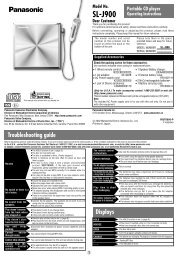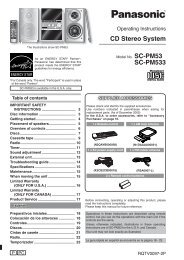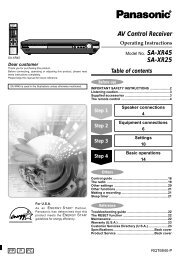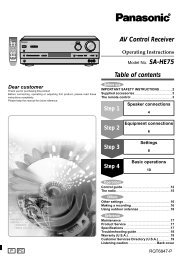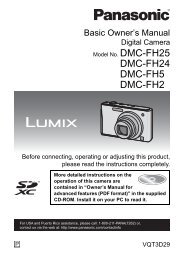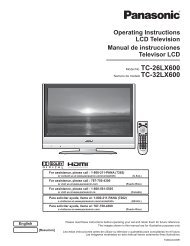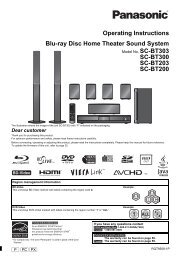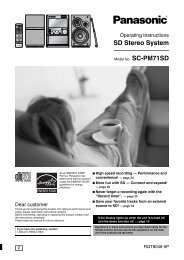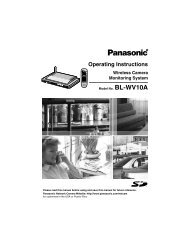Matsushita Electric Works, Ltd. - Panasonic
Matsushita Electric Works, Ltd. - Panasonic
Matsushita Electric Works, Ltd. - Panasonic
You also want an ePaper? Increase the reach of your titles
YUMPU automatically turns print PDFs into web optimized ePapers that Google loves.
Portable Oral Irrigator<br />
Irrigador oral portátil<br />
Model No. EW1270<br />
Modelo N.° EW1270<br />
Operating Instructions<br />
Instrucciones de funcionamiento<br />
Before operating this device, please read these instructions completely.<br />
Antes de usar este dispositivo, lea completamente estas instrucciones.<br />
INTRODUCTION<br />
Thank you for purchasing the <strong>Panasonic</strong> Oral Irrigator EW1270. With its<br />
water jet of 1,600 pulses per minute, the <strong>Panasonic</strong> Oral Irrigator gently<br />
yet thoroughly cleanses your teeth and gums, removing trapped food<br />
particles and reducing bacteria that can lead to gingivitis and other<br />
periodontal diseases. When used in combination with regular brushing<br />
and flossing, the <strong>Panasonic</strong> Oral Irrigator can help you have healthier<br />
teeth and gums.<br />
Before using this device, please read these instructions completely.<br />
Keep these instructions for reference.<br />
INTRODUCCIÓN<br />
Muchísimas gracias por haber adquirido el irrigador oral portátil<br />
EW1270. Con su chorro de agua de 1.600 pulsaciones por minuto, el<br />
irrigador oral portátil limpia sus dientes y encías de forma suave pero<br />
concienzuda, eliminando las partículas de comida atrapadas y<br />
reduciendo las bacterias que pueden causar gingivitis y otras<br />
enfermedades periodontales. Cuando se utilice en combinación con<br />
cepillo de dientes e hilo dental, el irrigador oral <strong>Panasonic</strong> le ayudará a<br />
tener unos dientes y encías más sanos.<br />
Antes de utilizar este aparato, lea completamente estas instrucciones y<br />
guárdelas para utilizarlas como referencia en el futuro.<br />
IMPORTANT SAFETY PRECAUTIONS<br />
1. Do not use while bathing.<br />
2. Do not place the device where it can slide, fall or be pulled into<br />
water.<br />
3. Close supervision is necessary when this device is used by, on or<br />
near children.<br />
4. KEEP JET NOZZLE ATTACHMENT AWAY FROM SMALL<br />
CHILDREN. The nozzle is small enough to be swallowed and can<br />
become lodged in the throat.<br />
5. Keep this device out of the reach of children when not in use.<br />
6. This device is designed for use only in the oral cavity. Do not direct<br />
water in delicate areas, such as under the tongue, in the eye, ear or<br />
nose, or in other delicate areas of the body.<br />
7. Use only attachments recommended by the manufacturer.<br />
8. DO NOT operate this product if it is not working properly or it has<br />
been dropped or damaged. If damaged or inoperative, return the<br />
product to a service center for inspection and repair.<br />
9. NEVER drop or insert any object into any opening on the device.<br />
10. Do not disassemble the device. Damage to the product and/or<br />
personal injury may occur.<br />
11. People with tooth or gum disease or people receiving oral treatment<br />
should consult their dentist before use.<br />
12. People who experience tooth or gum pain may not be able to use<br />
this device and should consult their dentist.<br />
13. NEVER use while drowsy.<br />
14. Remove the batteries from the device if it will not be used for more<br />
than a month. Otherwise, electrical leakage may occur if the<br />
insulator is worn.<br />
15. Fill the tank with water only.<br />
16. Certain types of mouthwash may damage the equipment by causing<br />
the housing or water tank to crack. Therefore, do not use<br />
mouthwash in the water tank.<br />
17. Improper handling of batteries may result in battery explosion or in<br />
corrosion from battery leakage. Please observe the following to<br />
ensure proper use of batteries.<br />
a. Be sure to turn off the power of the device after use.<br />
b. Do not mix different types or sizes of batteries.<br />
c. Replace all batteries at the same time. Do not mix old and new<br />
batteries.<br />
d. Be sure to insert batteries with correct polarity, as instructed.<br />
e. Remove batteries when they are worn out, and dispose of them<br />
properly according to all applicable environmental regulations.<br />
f. Do not disassemble or throw batteries into a fire.<br />
g. Do not short-circuit batteries.<br />
h. Do not charge the batteries included with this unit.<br />
PRECAUCIONES DE SEGURIDAD IMPORTANTES<br />
1. No lo utilice mientras se baña.<br />
2. No ponga el aparato donde pueda deslizarse, caerse o introducirse<br />
en el agua.<br />
<strong>Matsushita</strong> <strong>Electric</strong> <strong>Works</strong>, <strong>Ltd</strong>.<br />
1048, Kadoma, Osaka 571-8686, Japan<br />
No.1 EN, ES Printed in Japan<br />
BEFORE USE<br />
2<br />
Loading Batteries<br />
• Be sure to wipe the unit before installing the<br />
batteries so that no water enters the battery<br />
compartment.<br />
1. Twist the battery cover to the OPEN<br />
position and open it (Fig. 2).<br />
2. Insert two 1.5-V alkaline (AA/LR6)<br />
batteries, ensuring correct “+” and “–”<br />
polarity.<br />
• The device can be used approximately<br />
30 times (with one full tank of water per<br />
use) with a fresh set of <strong>Panasonic</strong><br />
alkaline batteries.<br />
• Do not mix old and new batteries.<br />
3. Twist the battery cover to the CLOSE<br />
position and close it.<br />
Note:<br />
The batteries’ power output is impaired at low<br />
temperature.<br />
CAUTION:<br />
Do not throw batteries into a fire. Doing so may result in an accident or<br />
explosion.<br />
ANTES DE UTILIZAR EL APARATO<br />
Carga de las pilas<br />
• Asegúrese de limpiar la unidad antes de instalar las pilas para que no<br />
entre agua en el compartimiento de las pilas.<br />
1. Gire la cubierta de las pilas hasta la posición OPEN y ábrala (figura<br />
2).<br />
2. Inserte dos pilas alcalinas de 1,5 V (AA/LR6), asegurándose de<br />
poner las polaridades “+” y “–” en las posiciones correctas.<br />
• Con pilas alcalinas <strong>Panasonic</strong> nuevas, el aparato puede utilizarse<br />
aproximadamente 30 veces (con un depósito lleno de agua por<br />
uso).<br />
• No mezcla pilas nuevas y viejas.<br />
3. Gire la cubierta de las pilas hacia la posición CLOSE y ciérrela.<br />
Nota:<br />
La potencia de las pilas se reduce a bajas temperaturas.<br />
PRECAUCIÓN:<br />
No tire las pilas al fuego. De lo contrario, puede causar un accidente o<br />
una explosion.<br />
USING YOUR ORAL IRRIGATOR<br />
(Figs. 3 & 4)<br />
• Rinsing your mouth with mouthwash is not a<br />
substitute for proper dental care. Brush your<br />
teeth or dental prosthesis for at least five<br />
minutes immediately after every meal, then<br />
use the device.<br />
1. Open the water tank lid.<br />
• The tank cannot be pulled out easily<br />
when the lid is closed.<br />
2. Pull the water tank section downward to<br />
the water tank usable line.<br />
3. Remove the nozzle from its compartment<br />
and insert firmly into the nozzle insertion<br />
hole until the nozzle clicks into place.<br />
4. Fill the tank with cold or warm water, not<br />
warmer than 40°C (104°F).<br />
• Do not put any toothpaste, powder or<br />
other chemicals into the water tank.<br />
• Certain types of mouthwash may damage<br />
the unit by causing the housing or tank to<br />
crack. Therefore, use only water in the<br />
water tank.<br />
CAUTION:<br />
NEVER fill the water tank with hot water!<br />
Sensitive gums can be easily irritated or<br />
damaged by hot water.<br />
5. Close the lid.<br />
3<br />
e<br />
4<br />
y<br />
NO<br />
w<br />
r<br />
qt<br />
YES
3. Cuando este aparato sea utilizado por un niño, con un niño o cerca<br />
de él deberá realizarse una supervisión cuidadosa.<br />
4. MANTENGA LA BOQUILLA DEL CHORRO DE AGUA ALEJADA<br />
DE LOS NIÑOS PEQUEÑOS. La boquilla es muy pequeña y puede<br />
ser tragada y quedarse alojada en la garganta.<br />
5. Mantenga este aparato fuera del alcance de los niños cuando no lo<br />
utilice.<br />
6. Este aparato ha sido diseñado para ser utilizado solamente en la<br />
cavidad oral. No dirija el agua a zonas delicadas tales como debajo<br />
de la lengua, los ojos, los oídos, la nariz u otras partes delicadas del<br />
cuerpo.<br />
7. Utilice solamente los accesorios recomendados por el fabricante.<br />
8. NO utilice este aparato si no funciona correctamente o si se ha<br />
caído o estropeado. Si se ha estropeado y no funciona, devuelva el<br />
producto a un centro de servicio para inspeccionarlo y repararlo.<br />
9. NUNCA deje caer el aparato ni inserte ningún objeto extraño por<br />
cualquiera de sus aberturas.<br />
10. No desmonte el aparato. Se pueden producir daños en el producto<br />
y/o lesiones personales.<br />
11. Las personas con enfermedades de los dientes o encías, o las que<br />
estén recibiendo tratamiento oral deberán consultar a sus dentistas<br />
antes de utilizar este aparato.<br />
12. Las personas con dolores de dientes o encías no deberán utilizar<br />
este aparato, y deberán consultar a sus dentistas.<br />
13. NUNCA utilice este aparato teniendo sueño.<br />
14. Quite las pilas del aparato si no va a utilizarlo durante más de un<br />
mes. De lo contrario pueden producirse fugas eléctricas si el<br />
aislador está desgastado.<br />
15. Llene el depósito de agua sólo con agua.<br />
16. Ciertos tipos de enjuagues pueden estropear el aparato haciendo<br />
que su caja o depósito de agua se agrieten. Por lo tanto, no utilice<br />
enjuagues en el depósito de agua.<br />
17. El manejo incorrecto de las pilas puede hacer que éstas revienten o<br />
que causen corrosión debido a sus fugas. Tenga en cuenta los<br />
puntos siguientes para asegurar un manejo correcto de las pilas.<br />
a. Asegúrese de desconectar la alimentación del aparato después de<br />
utilizarlo.<br />
b. No mezcle pilas de tipo o tamaño diferente.<br />
c. Sustituya todas las pilas al mismo tiempo. No mezcle pilas nuevas y<br />
viejas.<br />
d. Asegúrese de insertar las pilas poniendo las polaridades en las<br />
posiciones correctas.<br />
e. Quite las pilas cuanto estén agotadas, y disponga de ellas<br />
adecuadamente según los reglamentos ambientales aplicables.<br />
f. No desarme ni tire las pilas al fuego.<br />
g. No cortocircuite las pilas.<br />
h. No cargue las pilas incluidas con esta unidad.<br />
PARTS IDENTIFICATION (Fig. 1)<br />
Main unit<br />
q Battery cover<br />
w Nozzle insertion hole<br />
e Switch<br />
r Nozzle compartment<br />
t Water tank<br />
• There may be moisture inside the water<br />
tank and suction hose. This is moisture<br />
left from the distilled water used for<br />
product testing at the factory and is<br />
hygienically safe.<br />
y Water tank lid<br />
Accessory<br />
u Nozzle (1)<br />
IDENTIFICACIÓN DE LAS PIEZAS<br />
(Figura 1)<br />
Unidad principal<br />
q Cubierta de las pilas<br />
w Agujero de inserción de la boquilla<br />
e Interruptor<br />
r Compartimiento de la boquilla<br />
t Depósito de agua<br />
• En el interior del depósito de agua y de la manguera de succion<br />
puede haber humedad. Ésta es humedad que ha quedado del<br />
agua destilada utilizada para probar el aparato en fábrica, e<br />
higiénicamente no presenta ningún problema.<br />
y Tapa del depósito de agua<br />
Accesorio<br />
u Boquilla (1)<br />
1<br />
w<br />
r<br />
u<br />
q<br />
e<br />
t<br />
y<br />
6. Lean over the sink and place the nozzle in<br />
your mouth. Close your lips slightly to<br />
prevent splattering.<br />
• Hold the device upright when in use.<br />
u<br />
Excessive tilting can prevent the water<br />
from coming out of the nozzle.<br />
• The connecting section of the main unit<br />
and the water tank is not waterproof. When the tank is filled with<br />
water, be sure to place the device upright. Also, be sure to set the<br />
device down gently so that the bottom of the tank is not subjected to<br />
strong impact, which can cause the lid to open and the water to spill<br />
out.<br />
7. Slide the switch up to turn on the device.<br />
PRECAUTIONS:<br />
• Do not turn the switch on before putting the nozzle in your mouth.<br />
• Do not press the tip of the nozzle too firmly against your teeth or<br />
gums. Doing so may injure your gums.<br />
• If you are suffering from tooth or gum disease or receiving oral<br />
treatment, consult a dentist before use.<br />
• The device is designed exclusively for use in the oral cavity. Never<br />
use it for any other purpose.<br />
• During the first several uses, light bleeding of the gums may occur. If<br />
your gums are healthy, any bleeding should stop in one to two weeks.<br />
If bleeding persists for two or more weeks, consult your dentist before<br />
continuing use.<br />
UTILIZACIÓN DE SU IRRIGADOR ORAL (Figuras 3 y 4)<br />
• Enjuagarse la boca con enjuague o agua no es un sustituto para el<br />
cuidado apropiado de su boca. Cepille sus dientes o prótesis dental<br />
durante un mínimo de cinco minutos inmediatamente después de<br />
cada comida y luego utilice el aparato.<br />
1. Abra la tapa del depósito de agua.<br />
• El depósito no se puede sacar fácilmente cuando la tapa está<br />
cerrada.<br />
2. Baje la sección del depósito de agua hasta la línea de utilización del<br />
depósito de agua.<br />
3. Quite la boquilla de su compartimiento e insértela firmemente en el<br />
orificio de inserción de la boquilla hasta que ésta quede instalada<br />
haciendo un ruido seco.<br />
4. Llene el depósito con agua fría o templada que no supere los 40°C.<br />
• No ponga pasta de dientes, polvos u otros productos químicos en el<br />
interior del depósito de agua.<br />
• Ciertos tipos de enjuagues pueden estropear el aparato haciendo<br />
que su caja o depósito de agua se agrieten. Por lo utilice sólo agua<br />
en el depósito de agua.<br />
PRECAUCIÓN:<br />
NUNCA llene el depósito con agua caliente. El agua caliente puede<br />
irritar o lesionar fácilmente las encías.<br />
5. Cierre la tapa.<br />
6. Inclínese sobre el lavabo y ponga la boquilla en su boca. Cierre<br />
ligeramente sus labios para evitar salpicar.<br />
• Sujete el aparato en posición vertical cuando lo utilice. La<br />
inclinación excesiva puede impedir que el agua salga por la<br />
boquilla.<br />
• La sección de conexión de la unidad principal y el depósito de agua<br />
no es impermeable. Cuando el depósito se llene con agua,<br />
asegúrese de poner el aparato en posición vertical. Asegúrese<br />
también de bajar suavemente el aparato para que el fondo del<br />
depósito no sufra un fuerte impacto que podría causar la abertura<br />
de la tapa y el derrame del agua.<br />
7. Deslice el interruptor hacia arriba para encender el aparato.<br />
PRECAUCIONES:<br />
• No encienda el aparato antes de poner la boquilla en su boca.<br />
• No presione la punta de la boquilla con demasiada fuerza contra sus<br />
dientes o encías. De lo contrario podrá lesionar sus encías.<br />
• Si tiene enfermedades en los dientes o en las encías o está<br />
recibiendo tratamiento oral, consulte a un dentista antes de utilizar el<br />
aparato.<br />
• El aparato ha sido diseñado exclusivamente para ser utilizado en la<br />
cavidad oral. Nunca lo utilice con ninguna otra finalidad.<br />
• Durante las primeras veces que utilice el aparato sus encías podrán<br />
sangar ligeramente. Si sus encías están saludables dejará de sangrar<br />
en una o dos semanas. Si sigue sangrando durante más de dos<br />
semanas, consulte a su dentista antes de continuar utilizando el<br />
aparato.
TIPS ON USE<br />
1. Bend over the sink and hold the unit in an upright position with the<br />
nozzle tip pointing toward your teeth.<br />
2. Keep your mouth opened slightly so that the water can flow out.<br />
3. Starting in the back (molar) area and working toward the front teeth,<br />
systematically rinse all teeth and interdental spaces by:<br />
a directing the water jet flow at a right angle to the teeth and the<br />
area between the teeth and gums;<br />
b directing the water jet slowly along the teeth;<br />
c directing the water jet along the gumline with the nozzle tip at a<br />
right angle to the gum tissue;<br />
d cleaning between the teeth and around any braces, crowns or<br />
bridgework thoroughly.<br />
Notes:<br />
One full tank of water is not enough to rinse all of your teeth and gums<br />
adequately. We therefore recommend refilling the tank several times to<br />
ensure thorough cleaning of teeth and gums.<br />
• In addition to using the oral irrigator and brushing and flossing your<br />
teeth, we recommend regular checkups by a dentist as part of a<br />
complete dental hygiene program.<br />
CONSEJOS PARA LA UTILIZACIÓN<br />
1. Inclínese sobre el lavabo y sujete el aparato en posición vertical con<br />
la punta de la boquilla orientada hacia sus dientes.<br />
2. Mantenga la boca ligeramente abierta para que el agua pueda salir.<br />
3. Empezando por la zona de los dientes traseros (los molares) y<br />
avanzando hacia los dientes delanteros, aclare sistemáticamente<br />
cada diente y espacio entre dientes:<br />
a dirigiendo el chorro de agua en ángulo recto hacia los dientes y el<br />
área que se encuentra entre los dientes y las encías,<br />
b dirigiendo el chorro de agua lentamente a lo largo de los dientes,<br />
c dirigiendo el chorro de agua a lo largo de la línea de las encías,<br />
con la punta de la boquilla en ángulo recto hacia el tejido de las<br />
encías y,<br />
d limpiando concienzudamente entre los dientes y alrededor de<br />
cualquier aparato, coronas o puentes.<br />
Notas:<br />
Un depósito lleno de agua no es suficiente para limpiar adecuadamente<br />
todos sus dientes y las encías. Le recomendamos llenar varias veces el<br />
depósito para limpiar a fondo los dientes y las encías.<br />
• Además de utilizar el irrigador oral, un cepillo de dientes e hilo dental,<br />
recomendamos las revisiones periódicas de un dentista como parte<br />
de un programa de higiene dental completo.<br />
AFTER USE (Fig. 5)<br />
5<br />
1. Open the water tank lid and pour out the<br />
water.<br />
Caution: NEVER immerse the device in<br />
water.<br />
2. Turn on the device for a few seconds until<br />
any water remaining inside the device and<br />
nozzle drains out completely.<br />
Note:<br />
A small amount of water may remain inside<br />
the tank even after you have drained it by<br />
turning on the device for a few seconds. Be<br />
aware of such possible water drainage when<br />
you put away the device or pack it when<br />
traveling.<br />
3. Remove the nozzle and place it into the<br />
nozzle compartment.<br />
4. Push the tank up.<br />
• Be careful not to accidentally insert or<br />
pinch your finger.<br />
• When pushing the tank up, leave the lid open and make sure that<br />
the tip of the nozzle is inside the tank.<br />
5. Close the water tank lid.<br />
• After rinsing the unit, wipe and dry it well before storing the unit to<br />
prevent contamination and bacterial growth.<br />
DESPUÉS DE UTILIZAR EL APARATO (Figura 5)<br />
1. Abra la tapa del depósito de agua y meta el agua.<br />
Precaución: NUNCA sumerja el aparato en agua.<br />
2. Encienda el aparato durante unos pocos segundos hasta que el agua<br />
que queda en el interior de la unidad y de la boquilla se drene<br />
completamente.<br />
Nota:<br />
A pesar de drenar el agua encendiendo el aparato durante unos pocos<br />
segundos, existe la posibilidad de que quede una pequeña cantidad de<br />
agua en el interior del depósito. Tenga en cuenta esta pequeña<br />
cantidad de agua cuando guarde el aparato o lo embale para llevarlo<br />
cuando va de viaje.<br />
3. Quite la boquilla y póngala en su compartimiento.<br />
TROUBLESHOOTING – Possible causes and Remedies<br />
Problem<br />
The device stops<br />
immediately after<br />
being switched on or<br />
does not operate at<br />
all.<br />
Water pressure is too<br />
low or operating time<br />
is very short.<br />
The pump is running<br />
but no water comes<br />
out of the nozzle.<br />
If the device still does not function properly, stop using and contact an<br />
authorized service center or the store from which the device was<br />
purchased.<br />
CAUTION:<br />
• Never attempt to repair the device yourself.<br />
• If parts must be exchanged or replaced, or if the device malfunctions,<br />
contact an authorized service center.<br />
SPECIFICATIONS<br />
Power supply:<br />
Pump frequency:<br />
Water pressure:<br />
Battery life:<br />
Reservoir volume:<br />
Dimensions:<br />
Weight:<br />
Possible cause<br />
Batteries are not<br />
inserted properly.<br />
Battery power is<br />
low.<br />
Battery power is<br />
low.<br />
The tank is empty.<br />
The tank is not<br />
pulled down enough.<br />
Wrong position.<br />
The nozzle is<br />
clogged or deformed.<br />
Specifications are subject to change without notice.<br />
Remedy<br />
Insert the batteries<br />
properly. See the Loading<br />
Batteries section.<br />
Replace the batteries with<br />
new ones. See the<br />
Loading Batteries section.<br />
Replace the batteries with<br />
new ones. See the<br />
Loading Batteries section.<br />
Fill up tank with water.<br />
Pull down the tank fully.<br />
Use the device in an<br />
upright position with the<br />
nozzle pointing upwards.<br />
Replace the nozzle.<br />
3 V DC (Two 1.5-V alkaline batteries (AA/LR6))<br />
1600 pulses/minute<br />
approx. 440 kPa (approx. 4.5 kgf/cm 2 )<br />
approx. 20 minutes (with <strong>Panasonic</strong> alkaline<br />
AA/LR6 batteries)<br />
165 ml (approx. 40 seconds of use with new<br />
batteries)<br />
225(H) x 45(W) x 63(D) mm (9"(H) x 1-3/4"(W) x<br />
2-1/2"(D))<br />
150(H) x 45(W) x 63(D) mm (6"(H) x 1-3/4"(W) x<br />
2-1/2"(D)) when the tank is closed.<br />
200 g (7 oz) excluding batteries<br />
SOLUCIÓN DE PROBLEMAS – Causas posibles y remedios<br />
Problema<br />
El aparato se para<br />
inmediatamente<br />
después de haberlo<br />
encendido o no<br />
funciona en<br />
absoluto.<br />
La presión del agua<br />
está demasiado<br />
baja o el tiempo de<br />
operación es<br />
demasiado corto.<br />
La bomba funciona<br />
pero no sale agua<br />
por la boquilla.<br />
Causa posible<br />
Las pilas están mal<br />
insertadas.<br />
Las pilas están casi<br />
agotadas.<br />
Las pilas están casi<br />
agotadas.<br />
El depósito está<br />
vacío.<br />
El depósito no está lo<br />
suficientemente bajo.<br />
Posición equivocada.<br />
La boquilla está<br />
obstruida o deformada.<br />
Remedio<br />
Inserte correctamente las<br />
pilas. Consulte la sección<br />
Carga de las pilas.<br />
Sustituya las pilas por<br />
otras nuevas. Consulte la<br />
sección Carga de las<br />
pilas.<br />
Sustituya las pilas por<br />
otras nuevas. Consulte la<br />
sección Carga de las<br />
pilas.<br />
Llene el depósito con<br />
agua.<br />
Tire firmemente hacia<br />
abajo del depósito.<br />
Utilice el dispositivo en<br />
posición vertical con la<br />
boquilla hacia arriba.<br />
Sustituya la boquilla.<br />
Si el dispositivo sigue sin funcionar correctamente, deje de utilizarlo y<br />
póngase en contacto con un centro de servicio autorizado o con la<br />
tienda donde lo adquirió.<br />
PRECAUCIÓN<br />
• Nunca intente reparar el aparato usted mismo.<br />
• Si tiene que intercambiar o sustituir piezas, o si el dispositivo funciona<br />
mal, póngase en contacto con un centro de servicio autorizado.<br />
ESPECIFICACIONES<br />
Alimentación:<br />
3 V CC [dos pilas alcalinas de 1,5 V (AA/LR6)]<br />
Frecuencia de la bomba: 1.600 impulsos/minuto<br />
Presión del agua: 440 kPa aproximadamente (4,5 kgf/cm<br />
Duración de las pilas:<br />
Volumen del depósito:<br />
2<br />
aproximadamente)<br />
20 minutos aproximadamente (con pilas<br />
alcalinas <strong>Panasonic</strong> AA/LR6)<br />
165 ml (40 segundos aproximadamente de
4. Empuje el depósito hacia arriba.<br />
• Tenga cuidado para no meter o pellizcarse un dedo por accidente.<br />
• Cuando empuje el depósito hacia arriba, deje la tapa abierta y<br />
asegúrese de que la punta de la boquilla esté en el interior del<br />
depósito.<br />
5. Cierre la tapa del depósito de agua.<br />
• Después de aclarar la unidad, límpiela y séquela bien antes de<br />
guardarla para impedir que se contamine y puedan aparecer<br />
bacterias.<br />
MAINTENANCE<br />
q Nozzle<br />
Remove the nozzle from the device. Rinse<br />
6<br />
with water and wipe with a dry cloth.<br />
w Main unit<br />
Clean the main unit by wiping it with a<br />
cloth lightly dampened with liquid soap.<br />
• Use only water or a neutral cleaning<br />
#<br />
agent to clean the main unit. Never use<br />
caustic or abrasive agents (e.g., vinegar<br />
or lime-scale remover) because they<br />
may damage the device.<br />
$<br />
e Tank<br />
Pull the tank down firmly to remove it.<br />
Clean the inside with a soft brush or<br />
similar object if necessary.<br />
Wipe off any residue inside the tank. If the<br />
'<br />
%<br />
device will not be used for more than a<br />
week, be sure to dry the inside of the tank.<br />
r Water tank lid<br />
Wipe off to prevent water leakage.<br />
t Hose<br />
&<br />
Do not pull or bend the hose forcibly. Doing so may damage the<br />
hose and its spring.<br />
CAUTION:<br />
• Do not wash with hot water (exceeding 50°C or 122°F).<br />
• Do not immerse the main unit in water.<br />
Note:<br />
If the device will not be used for more than a month, be sure to remove<br />
the batteries.<br />
MANTENIMIENTO<br />
q Boquilla<br />
Quite la boquilla del aparato. Aclare con agua y luego pase un paño<br />
seco.<br />
w Unidad principal<br />
Limpie la unidad principal pasando un paño humedecido ligeramente<br />
en jabón líquido.<br />
• Utilice solamente agua o agente de limpieza neutro para limpiar la<br />
unidad principal. Nunca utilice sosa cáustica o agentes abrasivos<br />
(vinagre o limpiadores de cal o sarro por ejemplo) porque pueden<br />
estropear el aparato.<br />
e Depósito<br />
Empuje el depósito firmemente hacia abajo para retirarlo.<br />
Limpie el interior con un cepillo blando u objeto similar si es<br />
necesario.<br />
Limpie los residuos que pueda haber en el interior del depósito. Si el<br />
aparato no va a ser utilizado durante más de una semana,<br />
asegúrese de secar el interior del depósito.<br />
r Tapa del depósito de agua<br />
Séquela para impedir las fugas de agua.<br />
t Manguera<br />
No tire ni doble la manguera a la fuerza. De lo contrario podría dañar<br />
la manguera y su muelle.<br />
PRECAUCIÓN:<br />
• No lave el aparato con agua caliente (a más de 50°C).<br />
• No sumerja la unidad principal en agua.<br />
Nota:<br />
Asegúrese de quitar las pilas si el aparato no va a ser utilizado durante<br />
más de un mes.<br />
TRAVELING WITH THE PANASONIC ORAL<br />
IRRIGATOR<br />
Thanks to its handy shape and compact size, the <strong>Panasonic</strong> Oral<br />
Irrigator is an ideal traveling companion. When using it on a trip, be sure<br />
to completely drain the tank and nozzle before putting the device away.<br />
VIAJANDO CON EL IRRIGADOR ORAL PANASONIC<br />
Gracias a su forma práctica y tamaño compacto, el irrigador oral<br />
<strong>Panasonic</strong> es el compañero ideal para viajar. Cuando lo utilice en un<br />
viaje, asegúrese de vaciar completamente el depósito y la boquilla<br />
antes de guardarlo.<br />
Dimensiones:<br />
Peso:<br />
uso con pilas nuevas)<br />
225 (A) x 45 (An) x 63 (P) mm<br />
150 (A) x 45 (An) x 63 (P) mm cuando el<br />
depósito está cerrado<br />
200 g excluyendo las pilas<br />
Las especificaciones están sujetas a cambios sin previo aviso.





